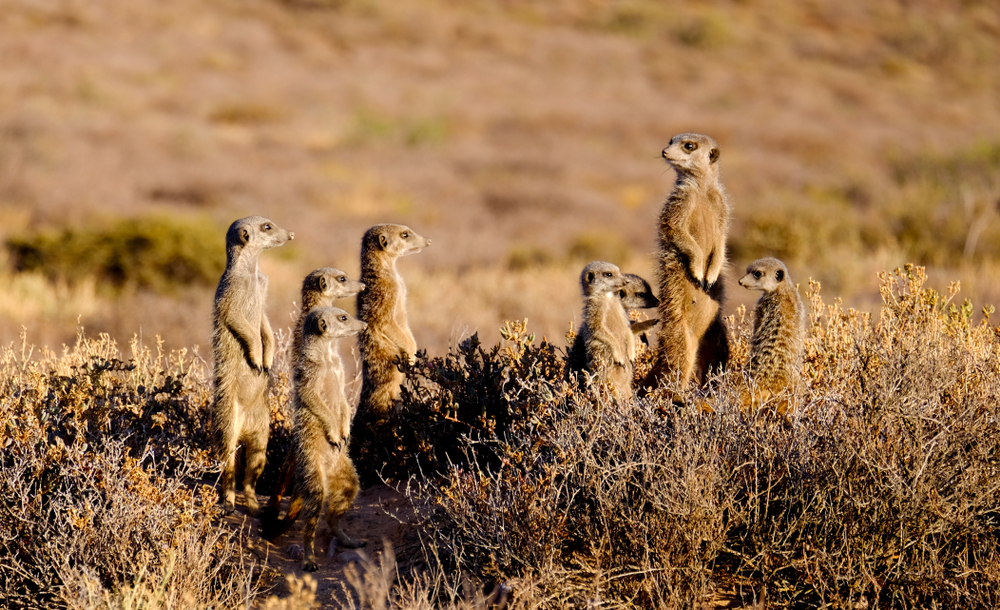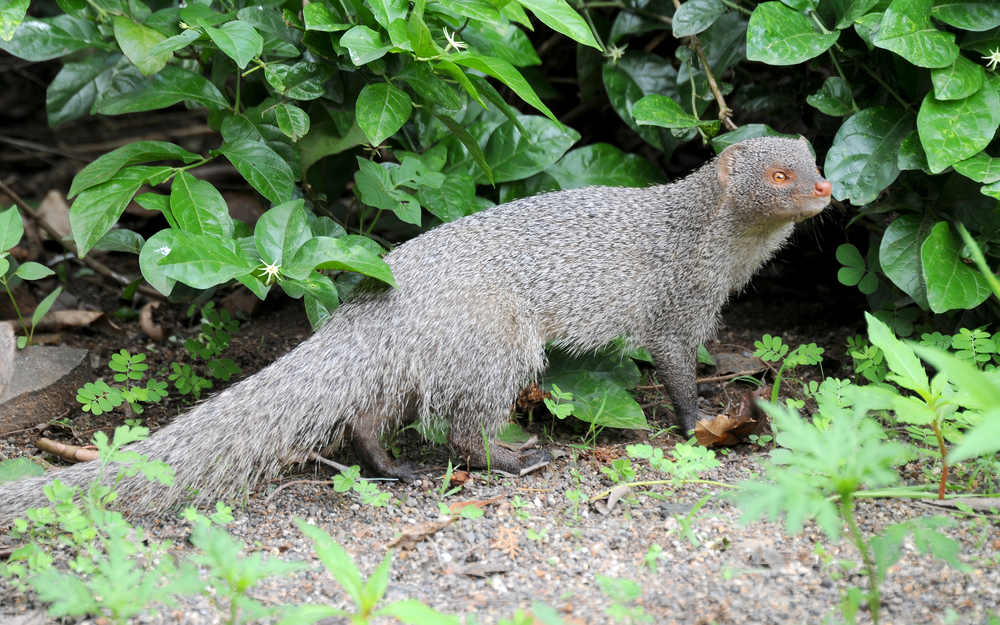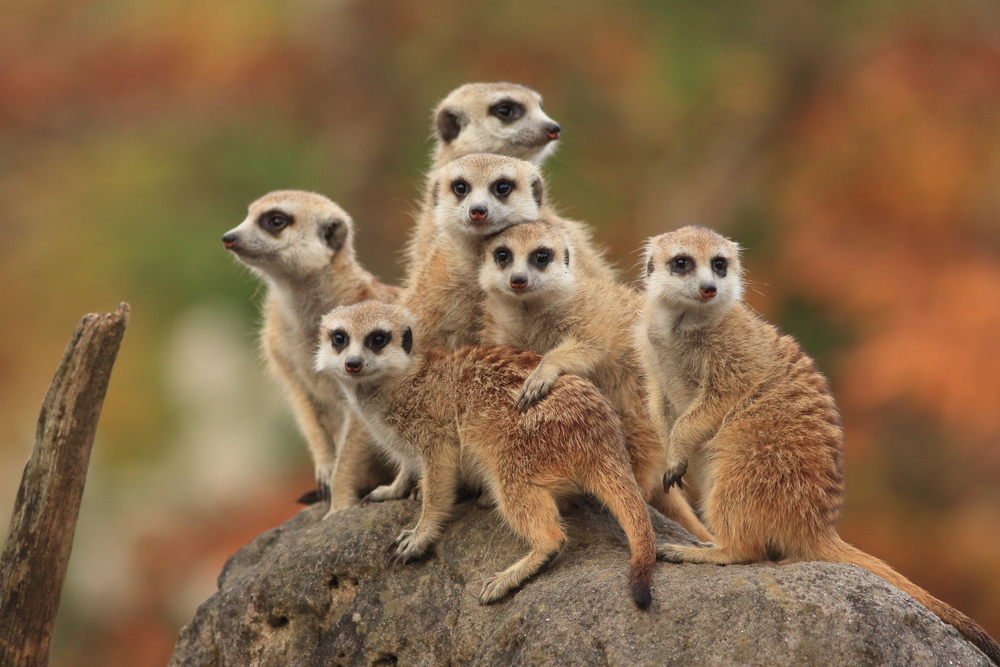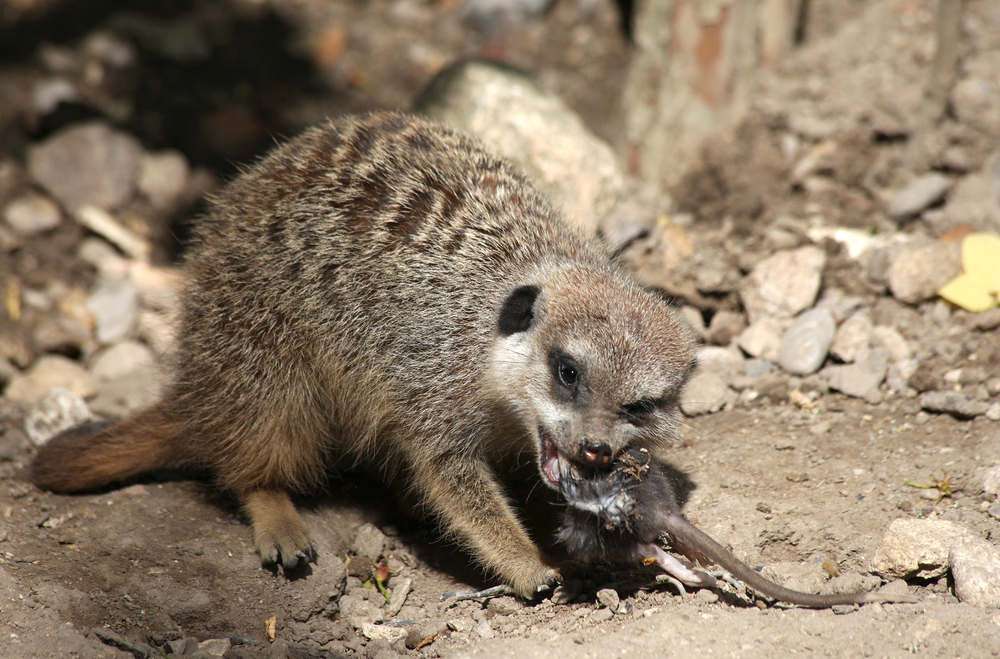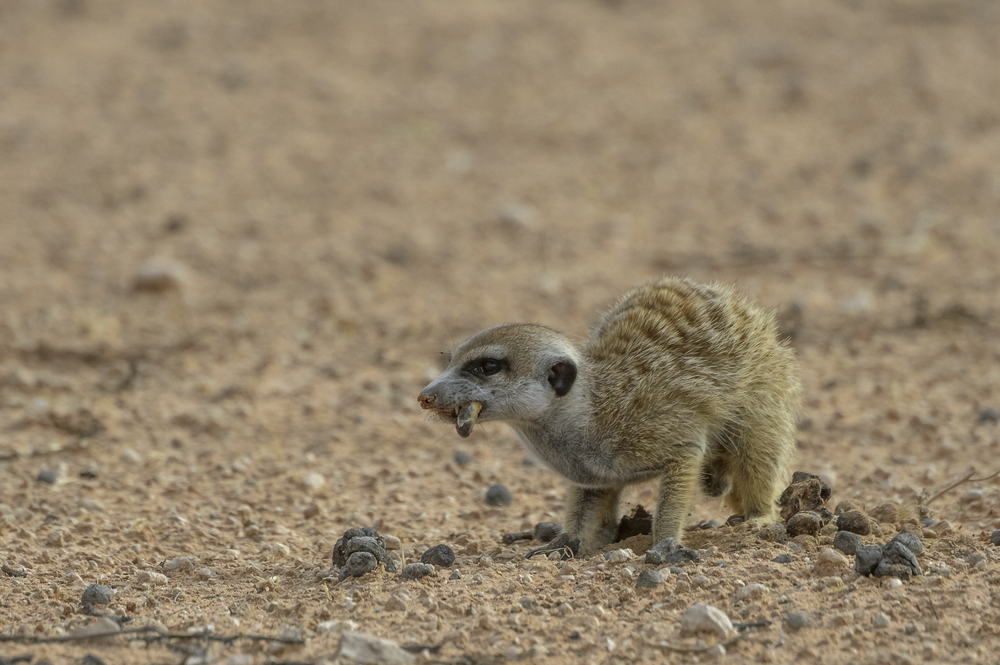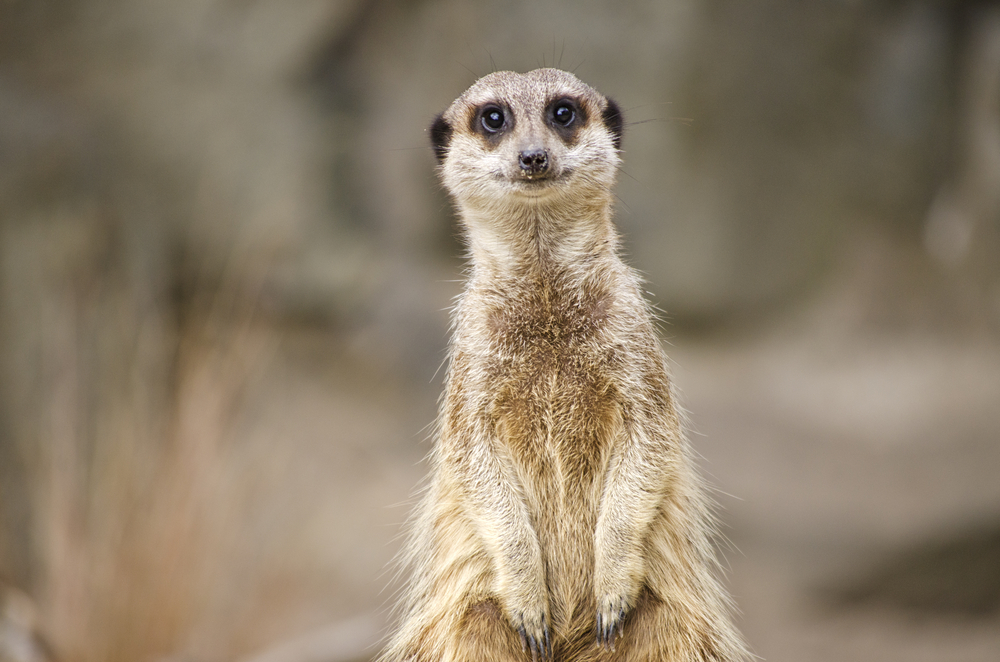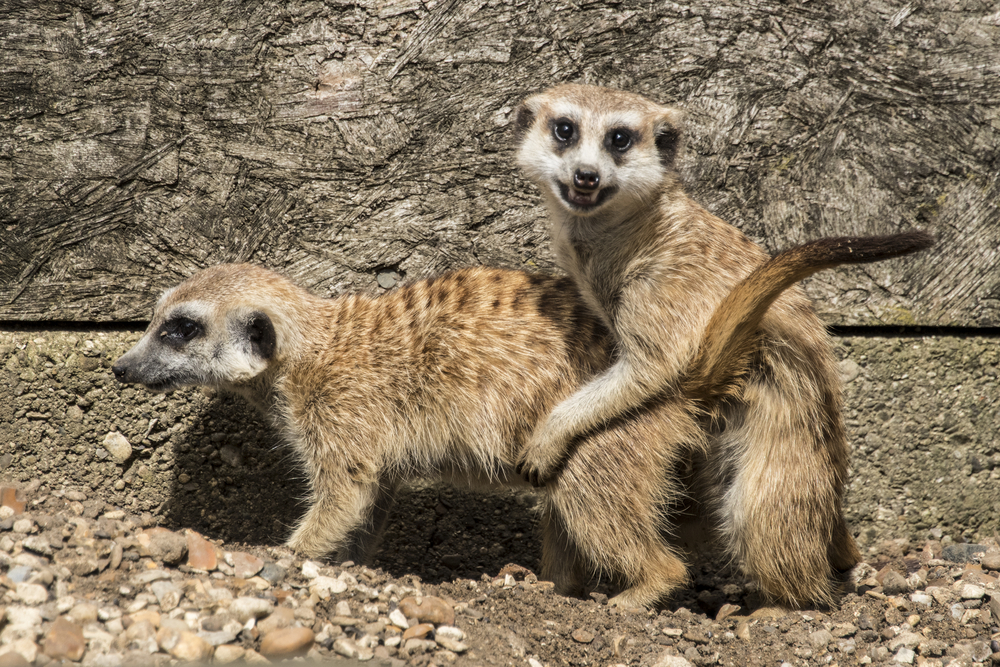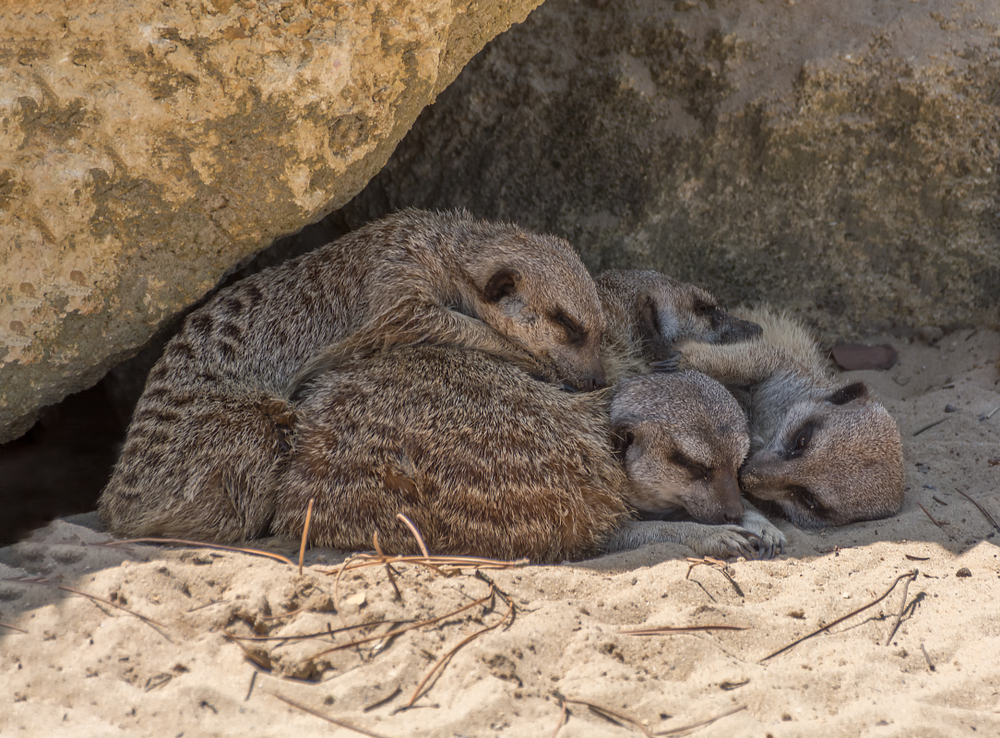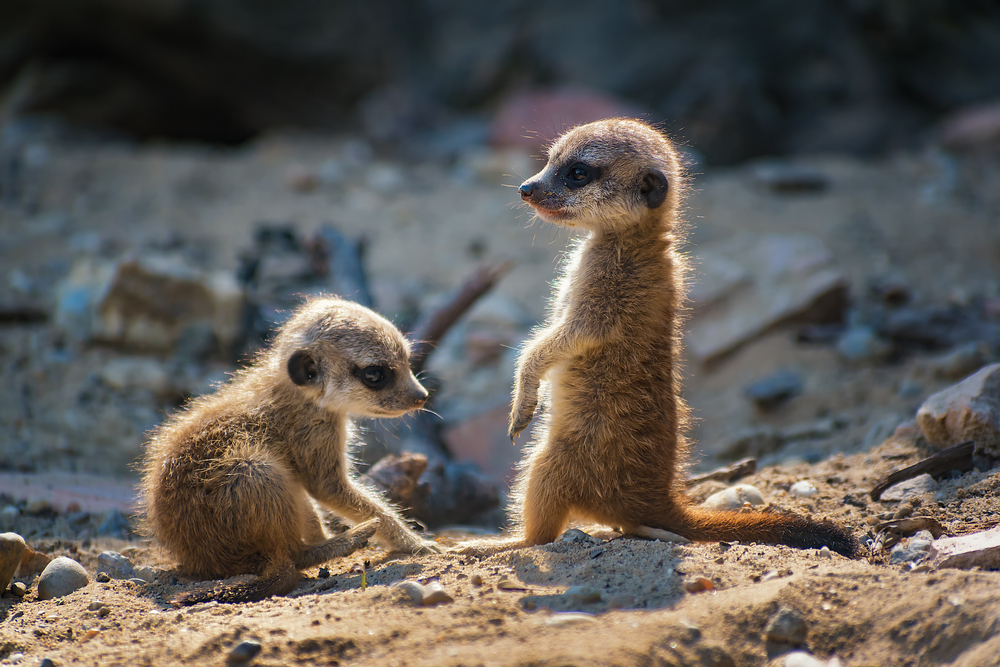About
The Meerkat, scientifically known as Suricata suricatta, belongs to the Animal Kingdom’s phylum Chordata, class Mammalia, and order Carnivora. It’s a member of the Herpestidae family, which includes mongooses. Meerkats are small carnivores native to the deserts and grasslands of southern Africa, particularly Botswana, Namibia, and South Africa.
These sociable creatures are well-known for their cooperative behavior and live in groups called mobs or gangs, consisting of 20 to 50 individuals. They exhibit complex social structures with specialized roles within the group, including sentinels that keep watch for predators while others forage for food.
Meerkats have a slender body, with a long, thin tail and distinctive dark bands around their eyes, giving them a masked appearance. They have sharp claws and powerful limbs adapted for digging burrows, where they shelter from predators and harsh weather conditions.
Their diet consists mainly of insects, but they also consume small vertebrates, eggs, fruits, and roots. Meerkats possess keen eyesight and acute hearing, which they use to detect both predators and prey in their arid habitats.
Conservation Concerns:
While Meerkat populations are currently stable and not at immediate risk, they face potential threats from habitat loss and fragmentation due to human activities such as agriculture and urbanization. Additionally, they may be affected by climate change, leading to alterations in their arid habitats.
As of now, the International Union for Conservation of Nature (IUCN) hasn’t evaluated Meerkats individually for conservation status, but they are listed under the Least Concern category in the Red List.
Physical Characteristics
The meerkat (Suricata suricatta) is a small mammal and a member of the mongoose family, native to the arid regions of southern Africa. Known for their social behavior, meerkats live in large groups called mobs or clans, which can consist of up to 50 members. These highly social animals are admired for their cooperative behavior and complex communication system. Here is a detailed overview of the physical characteristics of the meerkat:
Size
- Body Length: Meerkats are about 9.8 to 14 inches (25 to 35 centimeters) long, excluding their tail.
- Tail Length: Their tail adds another 7.5 to 9.8 inches (19 to 25 centimeters) to their length, which they use for balance and signaling to other meerkats.
- Weight: They weigh between 1.4 to 2.2 pounds (0.62 to 1 kilogram), with slight variations between individuals and seasons.
Physical Characteristics
- Body Shape: Meerkats have slender bodies with long, thin limbs, allowing them to stand upright on their rear legs. This posture is used for scanning the surroundings for predators.
- Fur and Coloration: Their fur is primarily sandy or light brown, which helps them blend into their desert surroundings. They have distinctive dark patches around their eyes, which reduce glare and enhance their vision under the bright sun. Dark, parallel stripes across their back are another characteristic feature, starting from the base of the tail and moving upwards.
- Head: The head is small and flat, with large, pointed ears that can close when the meerkat digs to prevent sand from entering.
- Eyes: They have large, dark eyes situated at the front of their face, providing them with excellent binocular vision. This vision is crucial for detecting predators and prey at a distance.
- Teeth: Meerkats have sharp teeth adapted for a diet that primarily includes insects, along with small mammals, birds, and fruit.
- Claws: Each of their four paws has long, non-retractable claws used for digging extensive tunnel systems in the desert. These burrows are where meerkats sleep, take refuge from predators, and raise their young.
Behavior and Adaptations
Meerkats are diurnal, spending the day foraging for food. They are excellent diggers, able to create complex underground networks. Their social structure is fascinating, with clear hierarchies and roles, including lookouts that alert the group to the presence of predators. Meerkats are known for their vigilance and ability to stand on their rear legs for extended periods, scanning their environment for threats.
Their physical adaptations, including fur coloration, body shape, and social behaviors, make meerkats well-suited to the harsh conditions of the southern African desert. This combination of traits has helped meerkats become one of the most successful small carnivores in their ecosystem.
Reproduction
Meerkats, known for their social behavior and cooperative living arrangements, have a fascinating reproductive cycle that is essential for the survival of their tight-knit groups. Here’s an overview:
Breeding Season: Meerkats breed throughout the year, but peak breeding activity often coincides with periods of abundant food resources, typically during the rainy season in their native habitats.
Dominance Hierarchy and Mating: Within a meerkat group, typically only the dominant alpha pair breeds. The alpha female is the primary breeder, although subordinate females may occasionally breed if conditions are favorable and resources are plentiful.
Courtship and Pair Formation: Courtship among meerkats involves complex behaviors such as scent marking, grooming, and vocalizations. Mating pairs engage in mutual grooming and other affiliative behaviors to reinforce their bond.
Gestation: After successful mating, the gestation period for meerkats lasts approximately 11 weeks, or around 70 days.
Birth and Litter Size: Meerkats typically give birth to litters of 2 to 5 pups, although litter sizes can vary depending on factors such as the mother’s age, health, and environmental conditions.
Maternal Care: Once the pups are born, they are initially blind and helpless. The mother provides extensive maternal care, nursing and protecting her offspring in a burrow within the group’s territory. Other group members, especially close relatives, may also assist in caring for and protecting the pups.
Weaning and Juvenile Development: Pups begin to emerge from the burrow at around 2 to 3 weeks of age, gradually becoming more active and adventurous as they grow. They are gradually weaned from their mother’s milk and transition to solid food, learning essential foraging skills from older members of the group.
Socialization and Education: Juvenile meerkats learn crucial social and survival skills through play and observation. They accompany adult group members on foraging expeditions and participate in sentry duty, where they learn to watch for predators and other threats.
Dispersal and Group Dynamics: As meerkats reach sexual maturity, typically around one year of age, they may disperse from their natal group to seek out new territories and mating opportunities. Some individuals may remain within the group as subordinate members, helping to care for future litters and contribute to group defense.
Reproductive Suppression: In some cases, subordinate females within a meerkat group may experience reproductive suppression, where their breeding behavior is inhibited by the dominant female’s pheromones or aggressive behavior. This phenomenon helps to maintain cohesion within the group and prevents overpopulation.
Environmental Influences: The reproductive cycle of meerkats is influenced by various environmental factors, including food availability, predation pressure, and habitat quality. Droughts, disease outbreaks, and human disturbances can also impact breeding success and population dynamics.
Understanding the reproductive cycle of meerkats is crucial for conservation efforts aimed at preserving their natural habitats and social structures. By protecting their habitats and minimizing human disturbances, conservationists can help ensure the long-term survival of these charismatic and highly social mammals.
Lifespan
The meerkat, a small mongoose species native to southern Africa, is renowned for its social behavior, including cooperative foraging, communal living in burrow systems, and sentinel duty to watch for predators. These highly social animals are adapted to arid environments and are often featured in popular culture for their endearing characteristics. The lifespan of meerkats can vary between wild populations and those in captivity due to differences in predation risk, environmental conditions, and access to healthcare.
Lifespan in the Wild: In their natural habitat, meerkats typically have a lifespan of around 12 to 14 years. However, individual lifespans can vary based on factors such as predation, disease prevalence, food availability, competition with other species, and environmental conditions. Despite their social structure and cooperative behavior, meerkats face various threats to their survival in the wild.
Lifespan in Captivity: Meerkats in captivity generally have longer lifespans compared to their wild counterparts. In well-managed zoos, wildlife parks, and research facilities, meerkats can live up to 12 to 15 years or more. Captive meerkats benefit from regular access to food, veterinary care, protection from predators, and controlled environments that mimic their natural habitat. Additionally, they are shielded from many of the threats faced by wild meerkat populations.
Threats to the Meerkat:
- Predation: Meerkats are preyed upon by a variety of predators, including birds of prey, snakes, jackals, and other carnivores. Their small size and vulnerability make them easy targets, especially when foraging or moving between burrows.
- Habitat Loss and Fragmentation: Habitat loss due to human activities such as agriculture, urbanization, and infrastructure development threatens meerkat populations. Fragmentation of their natural habitats can isolate populations, reducing genetic diversity and increasing vulnerability to extinction.
- Disease and Parasites: Meerkats are susceptible to various diseases and parasites, including rabies, tuberculosis, distemper, and fleas. Outbreaks of infectious diseases can spread rapidly within meerkat colonies, leading to significant mortality and population declines.
- Human-Wildlife Conflict: Encounters with humans, domestic animals, and livestock can pose threats to meerkats, particularly in areas where their natural habitats overlap with human settlements. Conflict situations may arise from competition for resources, predation on livestock, and retaliation killings.
- Climate Change: Climate variability and extreme weather events can impact meerkat populations by altering food availability, water sources, and habitat suitability. Changes in temperature and precipitation patterns may disrupt breeding cycles, foraging behavior, and overall population dynamics.
- Illegal Wildlife Trade: Although not a primary target for illegal wildlife trade, meerkats may be captured and sold as exotic pets or for display in the illegal wildlife market. Trafficking of meerkats threatens wild populations and undermines conservation efforts aimed at their protection.
Conservation efforts to safeguard meerkat populations include habitat conservation, protected area management, research on disease dynamics and population ecology, community-based conservation initiatives, and public education to raise awareness about the importance of preserving these iconic animals and their habitats. Collaborative approaches involving governments, conservation organizations, local communities, and stakeholders are essential for mitigating threats and ensuring the long-term survival of meerkats in the wild.
Eating Habits
The Meerkat (Suricata suricatta) is a small carnivorous mammal belonging to the mongoose family. These highly social creatures are native to the arid regions of southern Africa and are known for their cooperative foraging and unique feeding behaviors.
Diet: Meerkats primarily feed on a diet consisting of insects, particularly beetles, caterpillars, spiders, scorpions, and other small invertebrates. They may also occasionally consume small vertebrates such as lizards, rodents, birds, and eggs. While insects make up the bulk of their diet, they are opportunistic feeders and will consume a variety of prey items depending on availability.
Foraging Behavior: Meerkats are diurnal animals, meaning they are active during the day, and they spend much of their time foraging for food. They have keen eyesight and a keen sense of smell, which they use to locate prey. Meerkats employ a cooperative hunting strategy where they work together in groups called mobs or gangs to search for food.
Cooperative Foraging: When foraging, meerkats spread out in search of prey, with some individuals standing on their hind legs to scan the surroundings for potential threats or prey. Once prey is detected, they coordinate their movements and work together to catch and subdue it. This cooperative behavior allows them to successfully capture larger prey and increases their overall foraging efficiency.
Food Sharing: After capturing prey, meerkats may engage in food-sharing behavior within their social group. Dominant individuals often get priority access to food, but they may also share with other group members, particularly young or injured individuals. This social structure helps ensure the survival of the entire group, especially during times of scarcity.
Water Requirements: While meerkats can derive most of their moisture needs from their food, they still require access to water, especially during hot, dry periods. They obtain water from dew, succulent plants, or by digging for water in the sand if available.
Conservation Concerns: Meerkats face various threats in their natural habitat, including habitat loss, predation, and competition for resources with other species. Conservation efforts aimed at protecting their habitat and managing human-wildlife conflict are essential for ensuring the long-term survival of these charismatic animals.
Uniqueness
Meerkats (Suricata suricatta) are small, highly social mammals belonging to the mongoose family. Found in the arid regions of southern Africa, they are renowned for their cooperative behavior, intricate social structure, and adorable appearance. Here are some key aspects that make meerkats unique:
Social Structure: Meerkats live in tight-knit groups called mobs or clans, typically consisting of 5 to 50 individuals. Within these groups, there is a well-defined social hierarchy, with a dominant breeding pair leading the group and subordinate members fulfilling various roles such as sentries, babysitters, and hunters.
Cooperative Behavior: One of the most remarkable aspects of meerkat behavior is their cooperative nature. They work together to forage for food, defend territory, and raise young. Each member of the group plays a crucial role in ensuring the survival and well-being of the collective.
Sentinel Duty: Meerkats assign individuals to sentinel duty, where they stand upright on their hind legs, scanning the surroundings for potential predators while the rest of the group forages. These sentinels emit distinct alarm calls to alert the group of approaching threats, enabling them to take evasive action.
Burrow Systems: Meerkats inhabit complex underground burrow systems, which provide shelter from predators and extreme temperatures. These burrows can consist of multiple entrances, chambers, and tunnels, dug and maintained by the group collectively.
Dietary Habits: Meerkats are omnivorous, feeding on a variety of foods including insects, small mammals, reptiles, eggs, and plant matter. They have keen eyesight and a keen sense of smell, which they use to locate prey both above and below ground.
Reproductive Strategies: Breeding in meerkat groups is typically monopolized by the dominant pair, with subordinate members assisting in raising the young. Females give birth to litters of 2 to 5 pups, which are cared for by the entire group. Cooperative breeding helps ensure the survival of offspring in challenging desert environments.
Adaptations to Arid Environments: Meerkats are well-adapted to the arid habitats they inhabit. They have specialized kidneys that enable them to efficiently conserve water, and they are active during the cooler parts of the day to avoid overheating.
Cultural Significance: Meerkats have captured the hearts of people around the world through documentaries, cartoons, and popular culture. Their charming appearance, playful antics, and fascinating social dynamics make them beloved symbols of cooperation and resilience.
Conservation Status: While meerkats are not currently considered threatened, they face various challenges including habitat loss, predation by domestic animals, and persecution by humans. Conservation efforts aimed at protecting their natural habitats and raising awareness about their importance in ecosystems are crucial for their long-term survival.
Meerkats’ unique combination of social behavior, cooperative strategies, and adaptations to desert life make them a captivating and endearing species, cherished by both scientists and nature enthusiasts alike.
Related Family Species
Sources
- Alden, Peter et al, National Audubon Society Field Guide to African Wildlife, New York, NY.
- Burnie, David & Wilson, Don, Animal, Smithsonian Institute, Washington DC.
- Hickman et al, Integrated Principle of Zoology, McGraw Hill, Boston.
- Nolting, Mark, Africa’s Top Wildlife Countries, Global Travel Publishers, Inc., Ft. Laurderdale, FL.



































































